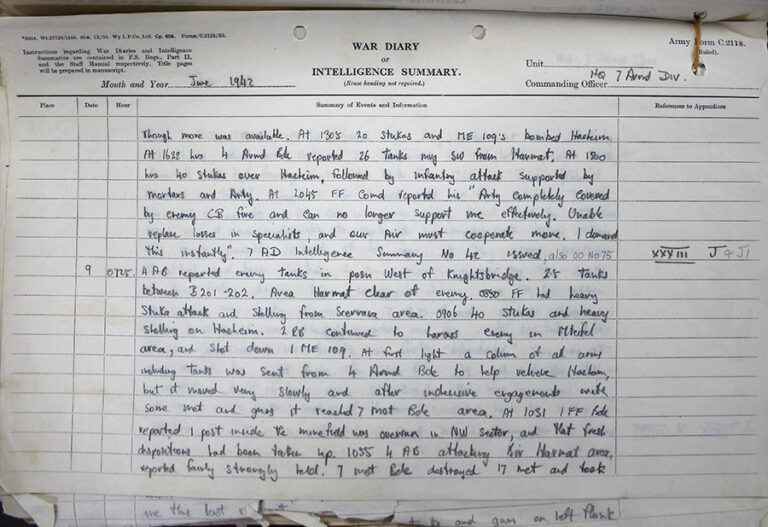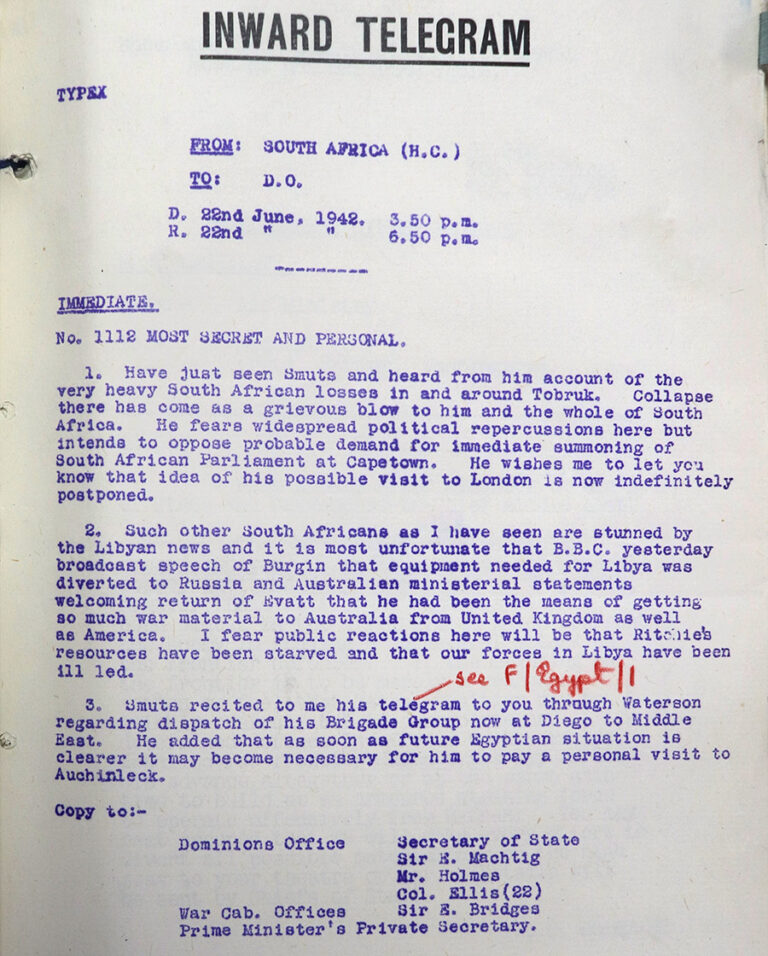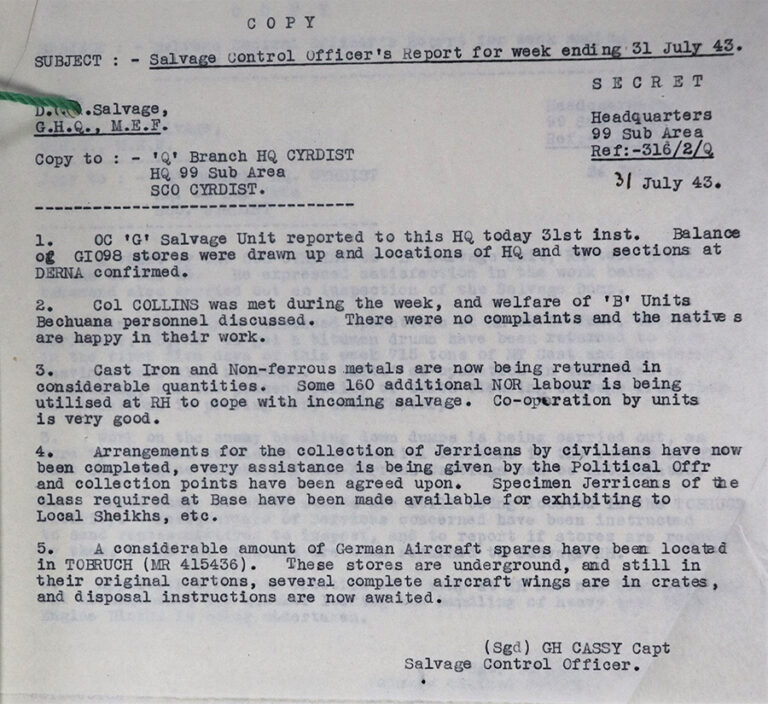The first part of this blog covered the capture and defence of Tobruk in 1941. Part two will deal mainly with the events of 1942, and the loss and reoccupation of the base.
Between battles: a hospital ship at Tobruk (December 1941 to March 1942)
As the siege came to an end the hospital ship Gloucestershire began making trips to pick up patients from Tobruk. During the first run the harbour was still under fire, though about 540 patients were collected and taken to Alexandria. An account of these trips was written by Acting or Assistant Matron E Townend of the Queen Alexandra’s Imperial Military Nursing Service, and is included in WO 222/2145.

Operation Venezia and the loss of Tobruk (January to June 1942)
Almost as soon as Operation Crusader was over, the Axis forces recovered and advanced again, still led by Rommel. The Allies fell back to Ain-el-Gazala, a hamlet just west of Tobruk, where they halted and began creating a new defensive line. There was then a lull in the campaign for several weeks, while both the Allied and Axis armies made preparations for the next battle.
In Tobruk itself the 2 South African Division was given command of the garrison, though the fixed defences of the base were in poor condition. Some of the mines in the fortress were moved to the new defensive line at Gazala, and the anti-tank ditch had fallen into disrepair. In the meantime, the role of Tobruk had also become uncertain, as the British senior commanders in the Middle East were reluctant to risk another siege should the Eighth Army be forced to retreat again.
On 26 May, Rommel launched his own offensive, named Operation Venezia, with the intention of capturing Tobruk. The initial moves are shown in the sketch map below (the advance by the Axis forces is at lower left).

The Battle of Gazala, as the operation is also known, is covered in a variety of files, and some examples are listed here. WO 169/4086 is the war diary of the headquarters of the 7 Armoured Division, which played a central role in the battle.

After a few weeks of fighting, the Allies were defeated. Most of the Eighth Army fell back into Egypt, but Tobruk itself was cut off. On 19 June, Axis troops launched an assault on the fortress and the garrison surrendered within two days. PREM 3/290/6 includes a telegram from General Auchinleck (the senior commander in the Middle East) to the Prime Minister with a warning that Tobruk was about to fall.

Following the surrender, Rommel made an address to the Axis troops which was intercepted as an Enigma decrypt.

Over 32,000 Allied personnel were taken prisoner – the second-largest surrender of British-led troops after the fall of Singapore a few months earlier. The effect of the surrender on South Africa is discussed in a variety of telegrams including one in CAB 121/620. The National Archives also holds German record cards of Allied prisoners of war in record series WO 416 and some examples are listed here.

Shortly before the loss of Tobruk the Prime Minister went to the United States to see President Roosevelt. When he returned to London he faced a debate in the House of Commons on the conduct of the war, and motion of no confidence, which was easily defeated. The loss of Tobruk is mentioned in Cabinet minutes at CAB 65/27/2.
In enemy hands (June to November 1942)
Tobruk continued to be used as a base while it was in Axis hands, with some shipping arriving there. In September, Allied forces launched a raid, known as Operation Agreement, intending to destroy supplies and equipment in Tobruk, but it was a failure. The Prime Minister made some comments on this operation in a file at PREM 3/311.

During this period Allied forces attacked Axis shipping sailing to Tobruk and, on 26 October, the Italian tanker Proserpina and cargo ship Tergestea were sunk by aircraft. The two ships are named in Enigma decrypt HW 1/1015. 47 Squadron took part in the attack on the Proserpina and the squadron operation record book can be found at AIR 27/464/6.
Recapture and aftermath
Following the victory at El Alamein, the Eighth Army advanced again into Libya, taking Tobruk unopposed on 13 November 1942. The base was completely secure this time, with the final defeat of the Axis forces in Tunisia in May 1943.
Salvage work in the vicinity of Tobruk went on for months after its recapture. The war diary of the Salvage Control Officer in Cyrenaica (WO 169/9298) mentions the large amounts of discarded equipment and material found there, such as scrap metal, Jerricans (petrol and water cans), aircraft spares (including complete German wings) and tanks.

In 1947 the Czechoslovak government made a request for a parcel of soil from Tobruk to be used in a ceremony in Czechoslovakia (some Czech troops had been present during the siege in late 1941). This request is mentioned in Foreign Office correspondence in FO 371/71320.
Conclusion
Tobruk was often the focal point of the campaign in North Africa for both the Allied and Axis forces, especially between the siege in 1941 and surrender in June 1942. Researchers who are interested in this topic will find plenty of useful sources at The National Archives. The selection shown in this article is representative of the available material.
Sgt. James Thomas Brown my Grandad from Wigan who was in 8th Army and fought in Africa El Alamein and Tobruk. Would love any information??